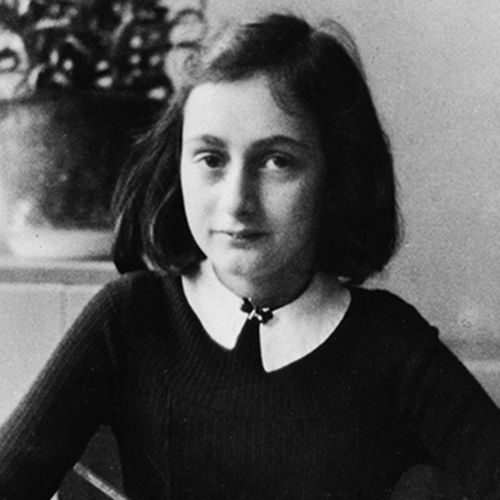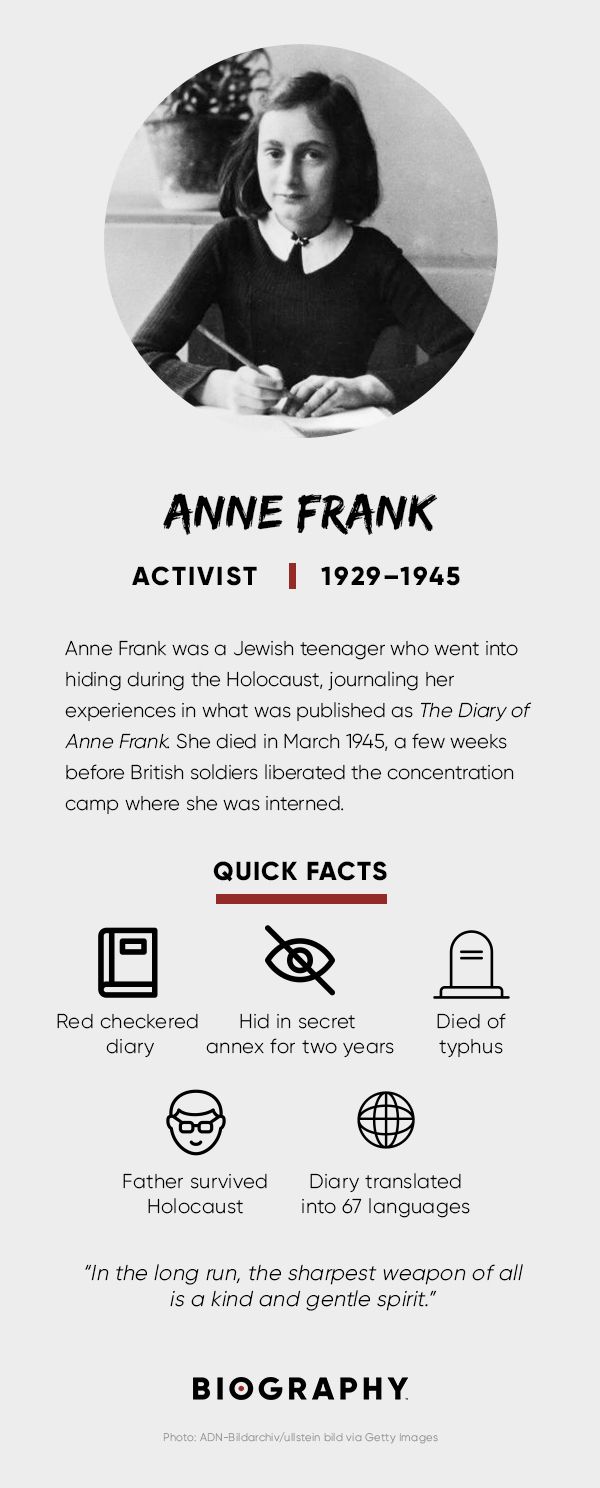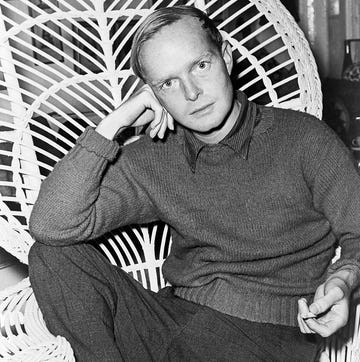(1929-1945)
Who Was Anne Frank?
Annelies Marie “Anne” Frank was a world-famous German-born diarist and World War II Holocaust victim. Her work, The Diary of Anne Frank, has been read by millions.
Fleeing Nazi persecution of Jews, the family moved to Amsterdam and later went into hiding for two years. During this time, Anne wrote about her experiences and wishes. In 1945, the family was found and sent to concentration camps, where Anne died at the age of 15.
Anne Frank's Family
Frank's mother was Edith Frank. Her father, Otto Frank, was a lieutenant in the German army during World War I, later becoming a businessman in Germany and the Netherlands. Anne had a sister named Margot, who was three years her senior. Otto was the only member of his immediate family to survive the concentration camps.
Early Life and Education
Anne was born on June 12, 1929, in Frankfurt, Germany. The Franks were a typical upper-middle-class, German-Jewish family living in a quiet, religiously diverse neighborhood near the outskirts of Frankfurt. But she was born on the eve of dramatic changes in German society that would soon disrupt her family's happy, tranquil life as well as the lives of all other German Jews.
Due in large part to the harsh sanctions imposed on Germany by the Treaty of Versailles that ended World War I, the German economy struggled terribly in the 1920s. During the late 1920s and early 1930s, the virulently anti-Semitic National German Socialist Workers Party (Nazi Party) led by Adolf Hitler became Germany's leading political force, winning control of the government in 1933.
"I can remember that as early as 1932, groups of Storm Troopers came marching by, singing, 'When Jewish blood splatters from the knife,'" Otto later recalled.
Fleeing to Amsterdam
When Hitler became chancellor of Germany on January 20, 1933, the Frank family immediately realized that it was time to flee. They moved to Amsterdam, Netherlands, in the fall of 1933.
Otto later said, "Though this did hurt me deeply, I realized that Germany was not the world, and I left my country forever."
Anne described the circumstances of her family's emigration years later in her diary: "Because we're Jewish, my father immigrated to Holland in 1933, where he became the managing director of the Dutch Opekta Company, which manufactures products used in making jam."
After years of enduring anti-Semitism in Germany, the Franks were relieved to once again enjoy freedom in their new hometown of Amsterdam. "In those days, it was possible for us to start over and to feel free," Otto recalled.
Anne began attending Amsterdam's Sixth Montessori School in 1934, and throughout the rest of the 1930s, she lived a relatively happy and normal childhood. Anne had many friends, Dutch and German, Jewish and Christian, and she was a bright and inquisitive student.
Nazi Occupation of The Netherlands
On September 1, 1939, Nazi Germany invaded Poland, igniting a global conflict that would become World War II. On May 10, 1940, the German army invaded the Netherlands. The Dutch surrendered on May 15, 1940, marking the beginning of the Nazi occupation of the Netherlands.
As Anne later wrote in her diary, "After May 1940, the good times were few and far between; first there was the war, then the capitulation and then the arrival of the Germans, which is when the trouble started for the Jews."
Beginning in October 1940, the Nazi occupiers imposed anti-Jewish measures in the Netherlands. Jews were required to wear a yellow Star of David at all times and observe a strict curfew; they were also forbidden from owning businesses. Anne and her sister were forced to transfer to a segregated Jewish school.
Otto managed to keep control of his company by officially signing ownership over to two of his Christian associates, Jo Kleiman and Victor Kugler, while continuing to run the company from behind the scenes.
Hiding in the Secret Annex
On July 5, 1942, Margot received an official summons to report to a Nazi work camp in Germany. The very next day, the Frank family went into hiding in makeshift quarters in an empty space at the back of Otto's company building, which they referred to as the Secret Annex.
The Franks were accompanied in hiding by Otto's business partner Hermann van Pels as well as his wife, Auguste, and son, Peter. Otto's employees Kleiman and Kugler, as well as Jan and Miep Gies and Bep Voskuijl, provided food and information about the outside world.
The families spent two years in hiding, never once stepping outside the dark, damp, sequestered portion of the building.
Concentration Camp
On August 4, 1944, a German secret police officer accompanied by four Dutch Nazis stormed into the Secret Annex, arresting everyone that was hiding there including Anne and her family. They had been betrayed by an anonymous tip, and the identity of their betrayer remains unknown to this day.
The residents of the Secret Annex were shipped off to Camp Westerbork, a concentration camp in the northeastern Netherlands. They arrived by a passenger train on August 8, 1944. In the middle of the night on September 3, 1944, they were transferred to the Auschwitz concentration camp in Poland. Upon arriving at Auschwitz, the men and women were separated. This was the last time that Otto ever saw his wife or daughters.
After several months of hard labor hauling heavy stones and grass mats, Anne and Margot were again transferred. They arrived at the Bergen-Belsen concentration camp in Germany during the winter, where food was scarce, sanitation was awful and disease ran rampant.
Their mother was not allowed to go with them. Edith fell ill and died at Auschwitz shortly after arriving at the camp, on January 6, 1945.
Anne Frank's Death
Anne and her sister Margot both came down with typhus in the early spring of 1945. They died within a day of each other in March 1945, only a few weeks before British soldiers liberated the German Bergen-Belsen concentration camp where they were interned. Anne was just 15 years old at the time of her death, one of more than 1 million Jewish children who died in the Holocaust.
At the end of the war, Anne father Otto, the sole survivor of the concentration camps, returned home to Amsterdam, searching desperately for news of his family. On July 18, 1945, he met two sisters who had been with Anne and Margot at Bergen-Belsen and delivered the tragic news of their deaths.
The Diary of Anne Frank
The Secret Annex: Diary Letters from June 14, 1942 to August 1, 1944 was a selection of passages from Anne's diary that was published on June 25, 1947, by her father Otto. The Diary of a Young Girl, as it's typically called in English, has since been published in 67 languages. Countless editions, as well as screen and stage adaptations, of the work have been created worldwide, and it remains one of the most moving and widely read firsthand accounts of the Jewish experience during the Holocaust.
On June 12, 1942, Anne's parents gave her a red-checkered diary for her 13th birthday. She wrote her first entry, addressed to an imaginary friend named Kitty, that same day: "I hope I will be able to confide everything to you, as I have never been able to confide in anyone, and I hope you will be a great source of comfort and support."
During the two years Anne spent hiding from the Nazis with her family in the Secret Annex in Amsterdam, she wrote extensive daily entries in her diary to pass the time. Some betrayed the depth of despair into which she occasionally sunk during day after day of confinement.
"I've reached the point where I hardly care whether I live or die," she wrote on February 3, 1944. "The world will keep on turning without me, and I can't do anything to change events anyway." The act of writing allowed Anne to maintain her sanity and her spirits. "When I write, I can shake off all my cares," she wrote on April 5, 1944.
When Otto returned to Amsterdam from the concentration camps at the end of the war, he found Anne's diary, which had been saved by Miep Gies. He eventually gathered the strength to read it. He was awestruck by what he discovered.
"There was revealed a completely different Anne to the child that I had lost," Otto wrote in a letter to his mother. "I had no idea of the depths of her thoughts and feelings."
For all its passages of despair, Anne's diary is essentially a story of faith, hope and love in the face of hate. "If she had been here, Anne would have been so proud," Otto said.
Anne's diary endures, not only because of the remarkable events she described but due to her extraordinary gifts as a storyteller and her indefatigable spirit through even the most horrific of circumstances.
"It's utterly impossible for me to build my life on a foundation of chaos, suffering and death," she wrote on July 15, 1944. "I see the world being slowly transformed into a wilderness; I hear the approaching thunder that, one day, will destroy us too. I feel the suffering of millions. And yet, when I look up at the sky, I somehow feel that everything will change for the better, that this cruelty too shall end, that peace and tranquility will return once more."
In addition to her diary, Anne filled a notebook with quotes from her favorite authors, original stories and the beginnings of a novel about her time in the Secret Annex. Her writings reveal a teenage girl with creativity, wisdom, depth of emotion and rhetorical power far beyond her years.
Anne Frank's Hidden Diary Pages & Dirty Jokes
In May 2018, researchers uncovered two hidden pages in Anne's diary that contained dirty jokes and "sexual matters," which the teen covered with pasted brown paper. “I sometimes imagine that someone might come to me and ask me to inform him about sexual matters,” Anne wrote in Dutch. “How would I go about it?”
Anne tried to answer these questions as if she's speaking to an imaginary person, using phrases like “rhythmical movements” to describe sex and “internal medicament,” alluding to contraception.
Anne also wrote about her menstrual cycle, saying it's "a sign that she is ripe," devoted space to "dirty jokes" and reference prostitution: "In Paris they have big houses for that.”
The pages were dated September 28, 1942, and were part of her first diary - the one she intended only for herself. “It is really interesting and adds meaning to our understanding of the diary," said Ronald Leopold, executive director of the Anne Frank House. “It’s a very cautious start to her becoming a writer.”
The Anne Frank House
After the end of World War II, the Secret Annex was on a list of buildings to be demolished, but a group of people in Amsterdam campaigned and set up the foundation now known as the Anne Frank House. The house preserved Anne's hiding spot; today it is one of the three most popular museums in Amsterdam.
In June 2013, the Anne Frank House lost a lawsuit to the Anne Frank Fonds, after the Fonds sued the House for the return of documents linked to Anne and Otto Frank. Anne's physical diary and other writings, however, are property of the Dutch state and have been on permanent loan to the House since 2009.
In 2015, the Fonds, the copyright holders of Anne's diary, lost a lawsuit against the Anne Frank House after the House began new scientific research on the texts in 2011.
In 2009, the Anne Frank Center USA launched a national initiative called the Sapling Project, planting saplings from a 170-year-old chestnut tree that Anne had long loved (as denoted in her diary) at 11 different sites nationwide.
QUICK FACTS
- Name: Annelies Marie Frank
- Birth Year: 1929
- Birth date: June 12, 1929
- Birth City: Frankfurt
- Birth Country: Germany
- Gender: Female
- Best Known For: Anne Frank was a Jewish teenager who went into hiding during the Holocaust, journaling her experiences in the renowned work 'The Diary of Anne Frank.'
- Industries
- World War II
- Journalism and Nonfiction
- Astrological Sign: Gemini
- Schools
- Sixth Montessori School
- Nacionalities
- German
- Interesting Facts
- Published in 1947, Anne Frank's Diary of a Young Girl has since been translated in 67 languages.
- Anne Frank died sometime in March 1945 from typhus, only a few weeks before British soldiers liberated the concentration camp where she was interned.
- Through a 2009 effort by the Anne Frank Center USA, saplings from a chestnut tree that Anne Frank loved were planted at 11 sites nationwide.
- Death Year: 1945
- Death City: Lower Saxony
- Death Country: Germany
Fact Check
We strive for accuracy and fairness.If you see something that doesn't look right,contact us!
CITATION INFORMATION
- Article Title: Anne Frank Biography
- Author: Biography.com Editors
- Website Name: The Biography.com website
- Url: https://www.biography.com/authors-writers/anne-frank
- Access Date:
- Publisher: A&E; Television Networks
- Last Updated: June 9, 2022
- Original Published Date: April 29, 2014
QUOTES
- It's utterly impossible for me to build my life on a foundation of chaos, suffering and death. I see the world being slowly transformed into a wilderness; I hear the approaching thunder that, one day, will destroy us too. I feel the suffering of millions. And yet, when I look up at the sky, I somehow feel that everything will change for the better, that this cruelty too shall end, that peace and tranquility will return once more.
- When I write, I can shake off all my cares.
- Despite everything, I believe that people are really good at heart.
- Think of all the beauty still left around you and be happy.
- A quiet conscience makes one strong!
- Although I'm only 14, I know quite well what I want. I know who is right and who is wrong. I have my opinions, my own ideas and principles, and although it might sound pretty mad from an adolescent, I feel more of a person than a child, I feel quite independent of anyone.
- As long as this exists, this sunshine and this cloudless sky, and as long as I can enjoy it, how can I be sad?
- The world will keep on turning without me, and I can't do anything to change events anyway.
- The weak die out, and the strong will survive, and live on forever.
- In the long run, the sharpest weapon of all is a kind and gentle spirit.
- People can tell you to keep your mouth shut but that doesn't stop you from having your own opinion.
- Whoever is happy will make others happy.
- No one has ever become poor by giving.
- I don't think of all the misery, but the beauty that still remains.
- It's really a wonder that I haven't dropped all my ideals, because they seem so absurd and impossible to carry out. Yet I keep them, because in spite of everything, I still believe that people are really good at heart.
- After May 1940, the good times were few and far between; first there was the war, then the capitulation and then the arrival of the Germans, which is when the trouble started for the Jews.
- Because we're Jewish, my father immigrated to Holland in 1933, where he became the managing director of the Dutch Opekta Company, which manufactures products used in making jam.

-[Public-domain],-via-Wikimedia-Commons-cropped.jpg?resize=980:*)












